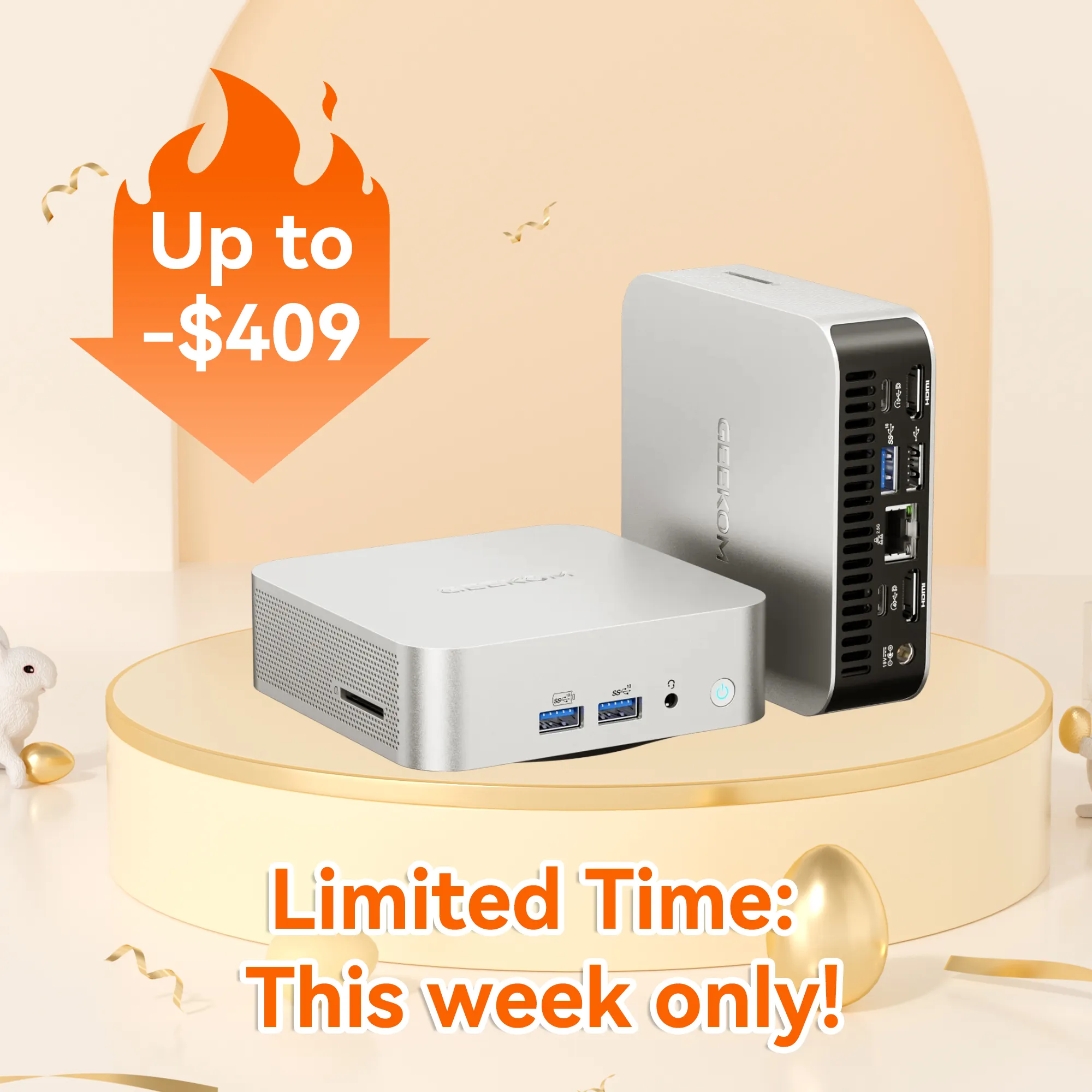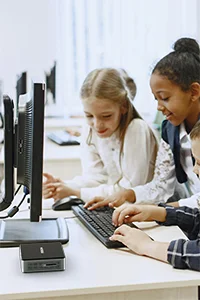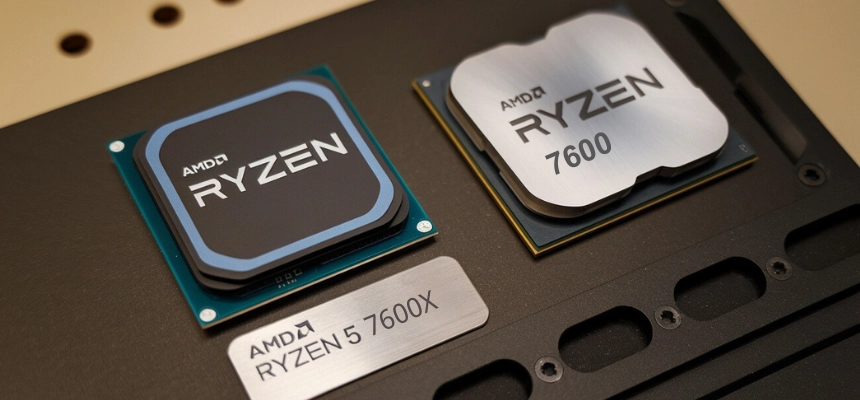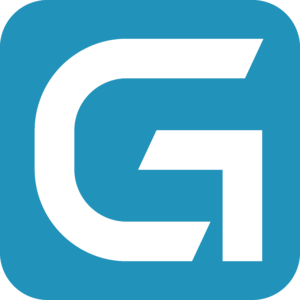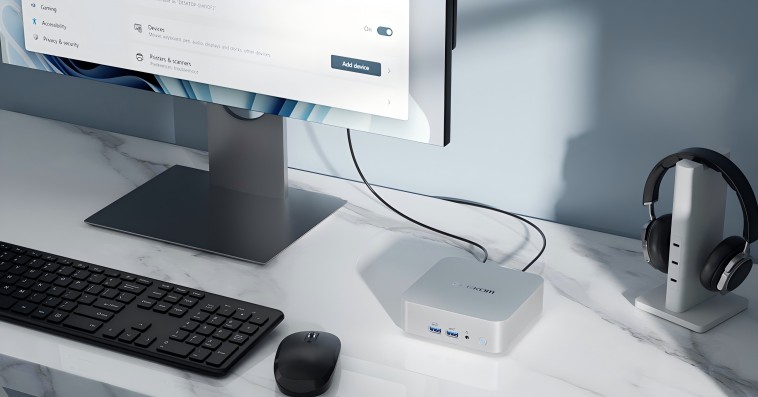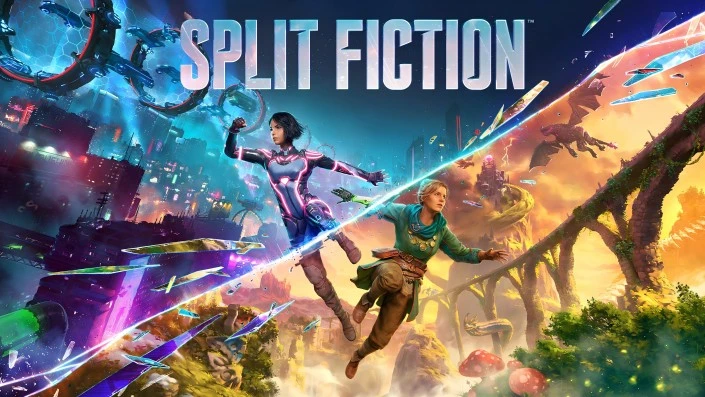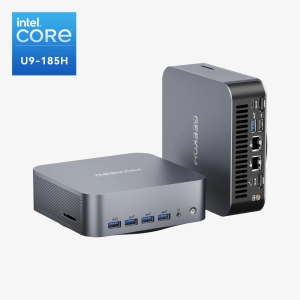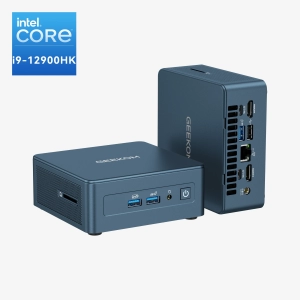Introduction
In this fast-paced business environment, the choice of a CPU increasingly influences system performance, game performance, content creation, and general multitasking. AMD Ryzen 5 series offers a zoned-out and energetically-speeded balance between performance and price. Two of the much-rater processors in this lineup are the Ryzen 5 7600 and the Ryzen 5 7600X, winner-takes-all-like competitors that position themselves to play different roles for different users.
This article proposes to compare the workings of the AMD Ryzen 5 7600 and the Ryzen 5 7600X on a large scale. The main aspects to be taken into account are the architecture, cores and threads, clock speed, power consumption, integrated graphics, support for memory, price, and performance. The difference between the two CPUs will affect the performance of gamers, content creators, and multitaskers.
7600 Vs 7600X: Architecture and Technology
The AMD Ryzen 5 7600 and Ryzen 5 7600X share the Zen 4 architecture, a progressive leap in CPU design emphasizing performance and efficiency. Built using the advanced 5nm process technology, these processors deliver significant gains in terms of performance per watt, which makes them suitable for applications ranging from gaming to productivity.
The AMD Ryzen 5 7600 balances strategically for lower cost out of the Ryzen-5 series, aimed at decent multi-core and single-core performance with lower energy consumption. It needs to address users who need decent performance across the board but do not push the envelope on power and thermal management. The fine 5nm architecture ensures power efficiency goes through the roof, therefore leading to cool temperatures and a lower carbon footprint, which is especially advantageous for smaller form factor systems and portable devices in the fold.
Compared to the 7600X, which appeals to enthusiasts and power users in need of unquestionable performance, the 7600 looks for the common user. The 7600X shares the same architecture and 5nm technology with the 7600 but is tuned to achieve higher clock speeds, resulting in better performance; thus, the one being situated in more demanding workloads, like the higher gaming frames performance, video rendering, and other performance-hungry applications. The greater power of the second has some effect on the maintenance of its temperature, which will allow it to work higher for more extended periods, making it more suited for systems with more efficient cooling designs.
Ryzen 5 7600 Vs 7600X: Specs
Here’s a detailed comparison of the key specifications between the AMD Ryzen 5 7600 and Ryzen 5 7600X:
| Specification | AMD Ryzen 5 7600 | AMD Ryzen 5 7600X |
|---|---|---|
| Architecture | Zen 4 | Zen 4 |
| Manufacturing Process | 5nm | 5nm |
| Cores/Threads | 6 cores / 12 threads | 6 cores / 12 threads |
| Base Clock Speed | 3.8 GHz | 4.7 GHz |
| Boost Clock Speed | 5.1 GHz | 5.3 GHz |
| TDP | 65W | 105W |
| Integrated Graphics | AMD Radeon™ Graphics | AMD Radeon™ Graphics |
| Memory Support | Up to 128GB DDR5 | Up to 128GB DDR5 |
| Connectivity | Wi-Fi 6E, Bluetooth 5.2 | Wi-Fi 6E, Bluetooth 5.2 |
The two processors are powered by the same core and the same architecture architecture: Zen 4 and the 5nm process respectively, but the differences between the two lie in clock speeds, TDP, and overall performance targets. The Ryzen 5 7600X is faster, both in base and boost speeds. It offers better performance in compute-demanding and single-threaded tasks.
TDP is one area that shows a very large disparity between the two chips. The Ryzen 5 7600 has a TDP of 65W, favoring energy efficiency which makes it suitable for those systems where overall power consumption and thermal management are priorities. With a TDP of 105W, the Ryzen 5 7600X, on the other hand, can deliver higher levels of performance for much longer, but requires a beefier cooling solution and uses substantially more power.
Core and Thread Count
Both AMD Ryzen 5 7600 and Ryzen 5 7600X boast 6 cores and 12 threads on the new Zen 4 architecture. This kind of arrangement makes those processors immensely capable of performing a majority of modern applications, anything between gaming and content creation and into some light multitasking workloads. The whole makes these processors able to handle multiple-process threads in parallel for a high-performance level suitable for users who perform heavy application usage alongside tasks such as video editing or rendering.
The Ryzen 5 7600, provided with low clock speeds, is primarily meant to combine performance and power efficiency. Even if it operates multitasking and multithreading load very well, it greatly targets users demanding adequate performance levels that do not need extreme processing power, making it ideal for gamers, general users, and professionals working on relatively lighter content creation jobs spread out for optimal performance-to-efficiency.
The Ryzen 5 7600X, while identical in the number of cores and threads, was supposedly marketed as the more performance-centric choice. Due to its higher base and boost clock, it will naturally suit tasks that would benefit more from faster single-threaded performance, like gaming at high frame rates or working with single-core optimized applications. As a result of its higher TDP offering somewhat greater thermal leeway, it can sustain that speed for a longer period, which gives it an edge when dealing with demanding workloads or under duress in multitasking environments.
Clock Speeds and Performance
Clock speeds remain one of the most varied aspects among the Ryzen 5 7600 and Ryzen 5 7600X. The AMD Ryzen 5 7600 provided the base clock is 3.8 GHz, where it can hit up to 5.1 GHz while in the boost clock mode. This amounts to a great performance ratio for general computing tasks, gaming, and productivity applications. Its clock speed also allows it to handle everyday workloads efficiently, avoiding the costly system deterrents of excessive power draw and heat generation.
In direct comparison, the AMD Ryzen 5 7600X has an enhanced base clock speed of 4.7 GHz with a value of up to 5.3 GHz for its boost clock speed. These higher clock speeds allow the general muscle of 7600X for performance-oriented tasks which make high demands for processing for comparatively smaller bursts: a mode of gaming at higher frame rates, as well as complex single-threaded applications. Increased base and boost frequencies place the Ryzen 5 7600X at the upper echelon on the various test grounds of single-core and multi-core functions: eager responsiveness and power burst being the hallmarks.
The Ryzen 5 7600X thus gives more overhead for processor-intensive workloads and better overall performance, though this is matched by higher power draw and heat under load. Ryzen 5 7600X will be a better choice for users who are looking for a more powerful CPU that can take a demanding workload such as high-resolution gaming, 3D rendering, or video editing.
Power Consumption and Thermal Management
Power consumption is the most significant differentiator between the Ryzen 5 7600 and the Ryzen 5 7600X. Rated at a lowly 65W TDP, the Ryzen 5 7600 is marketed as more energy-efficient. Lower power consumption translates to less heat generation, which can be favourable for users prioritizing quiet operation, reduced energy bills, and the feasibility of employing smaller or simpler cooling solutions. The Ryzen 5 7600 is a good fit for compact systems or builds where low-operating temperatures and energy efficiency are paramount, particularly in portable computers or energy-efficient workstations.
The Ryzen 5 7600X could potentially burn more energy, however, for that slight increase, the CPU can undergo tremendously high levels of performance. The ability to support high clock speeds over longer periods results in a useful performance under high demand, while the trade-off for providing that power is the actual heat increase that needs to be managed via adequate cooling gear. The 7600X will serve gamers and users with high-performance systems in need of capable cooling solutions much better.
Lastly, the Ryzen 5 7600 is apt for priority users in terms of power efficiency and thermal management, while those willing to tackle extra power and thermal considerations for greater performance would find the Ryzen 5 7600X more appropriate.
Memory Support and Compatibility
Both the AMD Ryzen 5 7600 and the Ryzen 5 7600X processors offer support for DDR5 memory, with a maximum capacity of 128GB. Memory in DDR5 features numerous advantages when compared with the preceding generation: higher bandwidth, higher efficiency, and better power conservation. Those processors are ready for memory-hungry workloads; they promise faster data access, which is a need for operations programs like video editing, 3D rendering, and virtual machine running. This memory support allows the processors to provide the necessary muscle for handling demanding tasks, while also providing far better multi-tasking capabilities.
Owing to the built-in support for DDR5 memory in both processors, users would consider these two processors forward-compatible with present applications running on memory-needful bandwidth. Thus, a gamer ensuring faster game load, a creator working with heavy media files, or a professional interacting with heavy data can be sure that these processors will provide smooth, responsive performance given the memory support.
Though both can support similar types and capacities of memory, the Ryzen 5 7600X has more room to utilize the faster memory frequency since it has higher clock speeds and higher TDP. This way, it can achieve better overall system performance in memory-intensive applications. The memory support in the Ryzen 5 7600, however, will be adequate for the memory requirements of many daily applications and gaming for most users.
Ryzen 5 7600 Vs 7600X: Benchmark Scores
| Benchmark | Ryzen 5 7600 | Ryzen 5 7600X |
|---|---|---|
| Cinebench R23 (Single-Core) | 1868 | 1,976 |
| Cinebench R23 (Multi-Core) | 14540 | 15315 |
| Geekbench 5 (Single-Core) | 2049 | 2197 |
| Geekbench 5 (Multi-Core) | 11147 | 11874 |
| PassMark (CPU Mark) | 27097 | 28464 |
Benchmark performance tests between the Ryzen 5 7600 and Ryzen 5 7600X show more or less the same performance in that while there is a performance gap, it is not particularly wide. The 7600X achieved 1,976 points for Cinebench R23 (Single-Core), while the 7600 scored 1,868 points, giving the 7600X a slight edge in single-threaded performance. The Multi-Core scores witness a similar trend, with the 7600X managing to score 15,315 to the 7600’s 14,540; this gives more over-multi-thread performance in all-core applications.
Single-core performance stands at 2,197 versus 2,049 for the 7600X and the 7600, while in Multi-Core scores, it is 11,874 versus 11,147 for the same processors. The conclusion here again is that the 7600X has an upper end as far as single and multi-core performance; although the margin is not huge.
Most importantly, PassMark (CPU Mark) gives the 7600X 28,464, a marginal win over the 7600, which scored 27,097-a conclusion that underlines-the 7600X has the general performance edge despite being incrementally better in all cases and therefore may not matter to all users at all. The Ryzen 5 7600 itself offers excellent performance in its price range for value shoppers.
Ryzen 5 7600X vs Ryzen 5 7600 Gaming Performance with Discrete Graphics
Both the AMD Ryzen 5 7600 and Ryzen 5 7600X require a discrete graphics card for gaming, as they do not come with integrated AMD Radeon™ Graphics. When paired with a capable discrete GPU, these processors can deliver excellent gaming performance, making them appealing to gamers who seek high frame rates and smooth gameplay.
Here is a comparison of gaming performance, peaked at 1080p resolution, using a discrete NVIDIA GeForce RTX 3060 Ti graphics card with settings between medium and high:
| Game | AMD Ryzen 5 7600 (RTX 3060 Ti) | AMD Ryzen 5 7600X (RTX 3060 Ti) |
|---|---|---|
| Fortnite | 120 FPS | 130 FPS |
| Valorant | 200 FPS | 210 FPS |
| CS:GO | 300 FPS | 320 FPS |
| Minecraft | 150 FPS | 160 FPS |
Ryzen 5 7600 Vs 7600X: Which Is Better For Gaming?
These two processors are powerhouses when it comes to gaming with a discrete GPU. The Ryzen 5 7600X is somewhat faster than the 7600 across nearly all tests, but the difference may not be significant for most casual gamers who don’t intend to push their systems to the limit. It’ll take a dedicated graphics card to run AAA titles on higher settings and resolutions for gamers intent on squeezing more from in-game performance.
Is the Ryzen 5 7600X good for gaming? This is one of the questions that users often ask. Both the Ryzen 5 7600X and 7600 will undoubtedly meet the needs of general-purpose users who might occasionally play games or primarily use their systems for other tasks. When paired with a discrete GPU, both processors can handle less demanding titles with ease and provide a solid gaming experience.
Price and Value Proposition
AMD positions the Ryzen 5 7600 and Ryzen 5 7600X into different price brackets targeting distinct segments of the market. The former is generally cheaper compared to the latter, thus catering to budget buyers. It is especially appealing to energy-conscious buyers who desire a competent processor for good productivity and gaming at its mid-range level.
The Ryzen 5 7600X, however, is positioned at a premium price range, and with that, it gives the user higher clock speeds, therefore serving better for handling tasks in gaming, video editing, and content generation. The extra power and performance make the 7600X an extremely attractive option for enthusiasts as well as for those who are looking at future-proofing their systems or requiring the extra processing power for some specific resource-hungry applications.
Cost-to-Performance Consideration:
- Ryzen 5 7600: Best suited for users who want solid performance without spending too much, ideal for mainstream users, casual gamers, and those building energy-efficient systems.
- Ryzen 5 7600X: Ideal for users who are willing to invest more for better overall performance, particularly those who engage in gaming, content creation, or other intensive tasks.
The ultimate decision between these two processors is whether you value performance or efficiency more. The Ryzen 5 7600 offers better value for money in terms of performance per dollar, but the Ryzen 5 7600X can provide extra performance for those willing to spend a bit more for higher clock speeds and better multitasking capabilities.
Of course, GEEKOM also offers the best solution, with an extremely high cost-performance ratio. You can choose the GEEKOM A5 mini PC.
★★★★★ ( 4.9 Based on 64 reviews)
- AMD Ryzen™ 7 5825U / 5800H Processor & Radeon™ Vega 8 Graphics.
- Up to 64GB dual-channel DDR4-3200 RAM.
- PCIe Gen 3 x4 NVMe/SATA SSD with up to 2TB of storage.
- Comprehensive I/O ports for full-featured connectivity.
- Support for 8K displays and multiple screens.
- Wi-Fi 6 and Bluetooth® v5.2.
Conclusion: Which One Should You Choose?
The choice between AMD Ryzen 5 7600 and Ryzen 5 7600X squarely depends on personal needs and budget limitations. They have a similar architecture to Zen 4 with fairly good performance but target a different type of user. Built to prioritize energy efficiency and with a wide budget range, the Ryzen 5 7600 is an impressive processor. With a TDP of 65W, it’ll work nicely for a reduced form factor system, or where the noise level must be low and aggressive cooling isn’t required. The Ryzen still performs well for day-to-day computing casual gaming and light content creation: excellent value for the regular mainstream user that doesn’t need sheer processing power.
The Ryzen 5 7600X, on the other hand, is targeted at power users and performance fanatics who need more speed and processing power. Being capable of working at higher clock speeds, 7600X with a TDP of 105W comes in handy for demanding applications such as high frame rate gaming, video editing, and multitasking. Extra power and clock speeds mean 7600X should satisfy users looking to “future-proof” their systems further build on the most resource-consuming applications. In return, it’s too much for the hardcore PS4 gamer, and without top-notch cooling, it will draw more power and run hotter.
In conclusion, the Ryzen 5 7600 would be perfect for a gaming, casual user, or a professional dealing with everyday applications and light gaming who doesn’t want to break the bank; the Ryzen 5 7600X is likely the better choice for an enthusiast, content creator, or a heavy user, willing to pay for better cooling solutions. Both are great chips, but which one is yours will depend on whether you value performance or efficiency the more.








